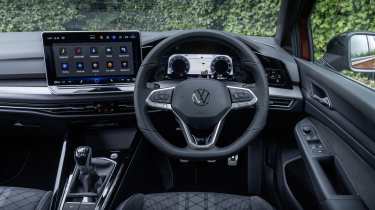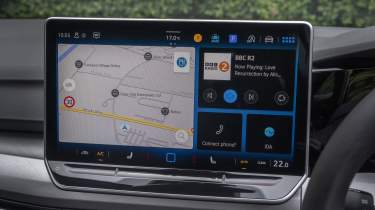Volkswagen Golf Mk8.5 – interior and tech
Improved materials, HMI and tech make the Mk8.5 Golf’s cabin a more pleasant place to be, but there’s still room for improvement
The vast majority of the criticism for the Mk8 Golf was directed squarely at its touch-sensitive HMI and awkward interior ergonomics. In response to this, Volkswagen worked hard to improve the Mk8.5 in these key areas, bringing physical steering wheel buttons back to all variants except the R, illuminated the touch sliders beneath the central display and improved infotainment response.
The result is a HMI that is much more pleasant to use than before, with accidental button activation and blind touch slider use a thing of the past. It’s not perfect, though. Those central touch sliders are still far from intuitive to use, with it difficult to tell which slider does what at a glance. While improved, the new UI for the 12.9-inch central display also has its niggles, with only a select few climate control functions remaining on the screen at all times – in our use, fan controls were always at least a click away, with heated seat controls seemingly taking priority.
> Volkswagen Golf R Mk8.5 2024 review – back to its best?
Thankfully that’s where the negatives end, with overall interior design pleasant. In the 114bhp eTSI we tested, a light interior colourway and full-length sunroof made for an airy, premium feel, with the use of fabric a refreshing sight – jump up a trim level and Alcantara elements bring an element of focus. Seat design is a little basic in lower trim levels, but move up to the R-Line and this is less of an issue, with more supportive bolsters, integrated headrests and (slightly tacky) faux carbonfibre trim included. The R-Line also swaps aluminium trim for gloss black, which adds a premium touch (before anyone’s applied fingerprints and scratches to it, at least).
More reviews
In-depth reviews
- Volkswagen Golf GTI 2025 review – the quintessential hot hatch improved but not perfected
- Volkswagen Golf R 2025 review – Mk8.5 not the return to form we'd hoped for
- Used VW Golf GTI (Mk7, 2013 - 2020) review – still the best hot hatch all-rounder
- Volkswagen Golf Mk8.5 2024 review – a return to form for the hatchback benchmark?
Reviews
The new software for the central display is now one of the snappiest in-car systems on the market, with immediate response and subtle audible feedback on button presses making it a pleasure to navigate. The layout of menus for vital car controls isn’t quite as intuitive as in the likes of the Ford Focus, for example, but the use of a customisable quick access panel is a welcome addition. Apple CarPlay is also well integrated, making use of the full display, unlike most cars. The digital dash doesn’t quite match this, which is very small in dimensions and has an unsightly plastic border as a result.
Overall ergonomics are good, with a sliding armrest making it easier to adapt the cabin to suit the driver, a thin-rimmed steering wheel always nice to see, and good visibility all-round not a given in 2024. Volkswagen says it has worked on improving material quality throughout, too, and while hard plastics are still present, they're mostly limited to the lower portions of the cabin – soft touch materials feature on the dash and virtually any easily accessible area. A few elements such as the rear air vents, select components in the boot and transmission tunnel are still lacking in quality, but there has been a noticeable improvement nonetheless.
As a result, refinement is strong overall, with limited powertrain noise in the cabin and few rattles and squeaks. A-pillar wind noise and tyre road in the R-Line was on the high side in our test, but this could be limited to our particular test car.




